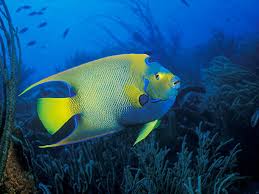Queen Angelfish: Vibrant Guardians of the Caribbean’s Coral Reefs and Their Crucial Role in Marine Biodiversity and Ecosystem Balance
The Queen Angelfish (Holacanthus ciliaris) is a vibrant and captivating species native to the tropical waters of the western Atlantic Ocean, particularly the Caribbean Sea. Known for their striking appearance and graceful movements, Queen Angelfish are among the most iconic marine creatures in the region, contributing significantly to the biodiversity and ecological balance of coral reef ecosystems.
Physical Characteristics
Queen Angelfish are renowned for their vivid coloration and intricate patterns. They exhibit a dazzling palette of blues, yellows, and purples, with a distinctive, crown-like spot on their forehead, which gives them their regal name. Their bodies are primarily a brilliant blue, adorned with yellow scales that create a striking contrast. The dorsal and anal fins are edged with a bold, electric blue, while the tail fin is bright yellow. Juvenile Queen Angelfish differ slightly in appearance, featuring vertical blue and white bars that fade as they mature.
Adult Queen Angelfish can grow up to 45 centimeters (18 inches) in length, with a laterally compressed body that allows them to navigate the complex structures of coral reefs. Their small mouths are equipped with comb-like teeth, adapted for grazing on a variety of food sources.

Gorgeous Queen Angelfish
Habitat and Distribution
Queen Angelfish inhabit the warm, clear waters of the western Atlantic, ranging from Florida and the Bahamas through the Caribbean Sea to the northern coast of South America. They are typically found at depths of 1 to 70 meters (3 to 230 feet), favoring coral reefs, rocky ledges, and seagrass beds. These environments provide ample food and shelter, essential for their survival and reproduction.
Coral reefs, in particular, are crucial habitats for Queen Angelfish. The intricate structures of reefs offer numerous hiding spots from predators and serve as rich feeding grounds. The health of these reefs is directly linked to the well-being of Queen Angelfish populations, as they rely on the abundance of sponges and other invertebrates found within these ecosystems.
Diet and Feeding Behavior
Queen Angelfish are omnivorous, with a diet that primarily consists of sponges. Their specialized, comb-like teeth enable them to graze on sponges efficiently, extracting nutrients while avoiding the spicules that deter many other species. In addition to sponges, Queen Angelfish also consume algae, tunicates, and various invertebrates. This diverse diet helps maintain the health of coral reef ecosystems by controlling sponge populations and promoting algal diversity.
Feeding behavior in Queen Angelfish is methodical and deliberate. They are often seen swimming slowly over the reef, carefully selecting and nibbling at their preferred food sources. This feeding strategy not only sustains the fish but also plays a role in the broader ecological dynamics of the reef, as it influences the distribution and abundance of sponges and algae.
Reproduction and Lifecycle
Reproduction in Queen Angelfish involves intricate courtship displays and spawning rituals. During the breeding season, which typically occurs from April to September, males and females engage in a synchronized dance, swimming in tight circles and ascending in the water column. This behavior culminates in the release of eggs and sperm into the water, where external fertilization occurs.
A single spawning event can produce thousands of eggs, which hatch into larvae within 15 to 20 hours. These larvae are planktonic, drifting with the currents for several weeks before settling onto the reef and undergoing metamorphosis into juvenile angelfish. The early stages of life are perilous, with high mortality rates due to predation and environmental factors. However, those that survive grow rapidly, reaching sexual maturity within two to three years.
Ecological Role and Conservation
Queen Angelfish play a vital role in the health and stability of coral reef ecosystems. By feeding on sponges, they help regulate sponge populations, preventing them from overwhelming the reef and competing with corals for space and resources. Their grazing also promotes algal diversity, which supports a variety of other marine organisms.
Despite their ecological importance, Queen Angelfish face several threats. Habitat destruction, particularly the degradation of coral reefs due to climate change, pollution, and overfishing, poses significant risks. Coral bleaching and ocean acidification, driven by rising sea temperatures and increased CO2 levels, directly impact the health of reef habitats and, consequently, the populations of species that depend on them, including Queen Angelfish.
Overfishing and the aquarium trade also threaten Queen Angelfish. They are a popular choice for marine aquariums due to their striking appearance, leading to unsustainable harvesting practices in some areas. This exploitation can reduce wild populations, disrupt local ecosystems, and threaten the species’ long-term survival.
Conservation Efforts
Conservation efforts aimed at protecting Queen Angelfish and their habitats are crucial for maintaining the biodiversity and ecological integrity of coral reefs. Marine protected areas (MPAs) play a significant role in safeguarding these fish by restricting fishing activities and preserving critical habitats. Additionally, sustainable fishing practices and regulations on the aquarium trade can help mitigate the pressures on wild populations.
Public awareness and education are also essential components of conservation. By promoting the importance of coral reefs and the species that inhabit them, including Queen Angelfish, conservation organizations can foster a sense of stewardship and encourage responsible behavior among local communities and tourists.
Research and monitoring efforts are vital for understanding the population dynamics, health, and threats facing Queen Angelfish. Scientists use various methods, including underwater surveys and tagging studies, to gather data on their distribution, behavior, and reproductive patterns. This information is crucial for developing effective conservation strategies and ensuring the long-term survival of the species.

Adult Queen Angelfish
Conclusion
The Queen Angelfish is a symbol of the beauty and diversity of the Caribbean’s marine life. Its vibrant colors and graceful movements captivate divers and snorkelers, while its ecological role highlights the interconnectedness of coral reef ecosystems. Protecting this iconic species requires concerted efforts to preserve their habitats, regulate human activities, and promote sustainable practices. Through dedicated conservation initiatives and increased public awareness, we can ensure that future generations continue to marvel at the splendor of the Queen Angelfish and the vibrant reefs they call home.
- Posted in:
- Conservation
- Coral Reefs
- Marine Life
